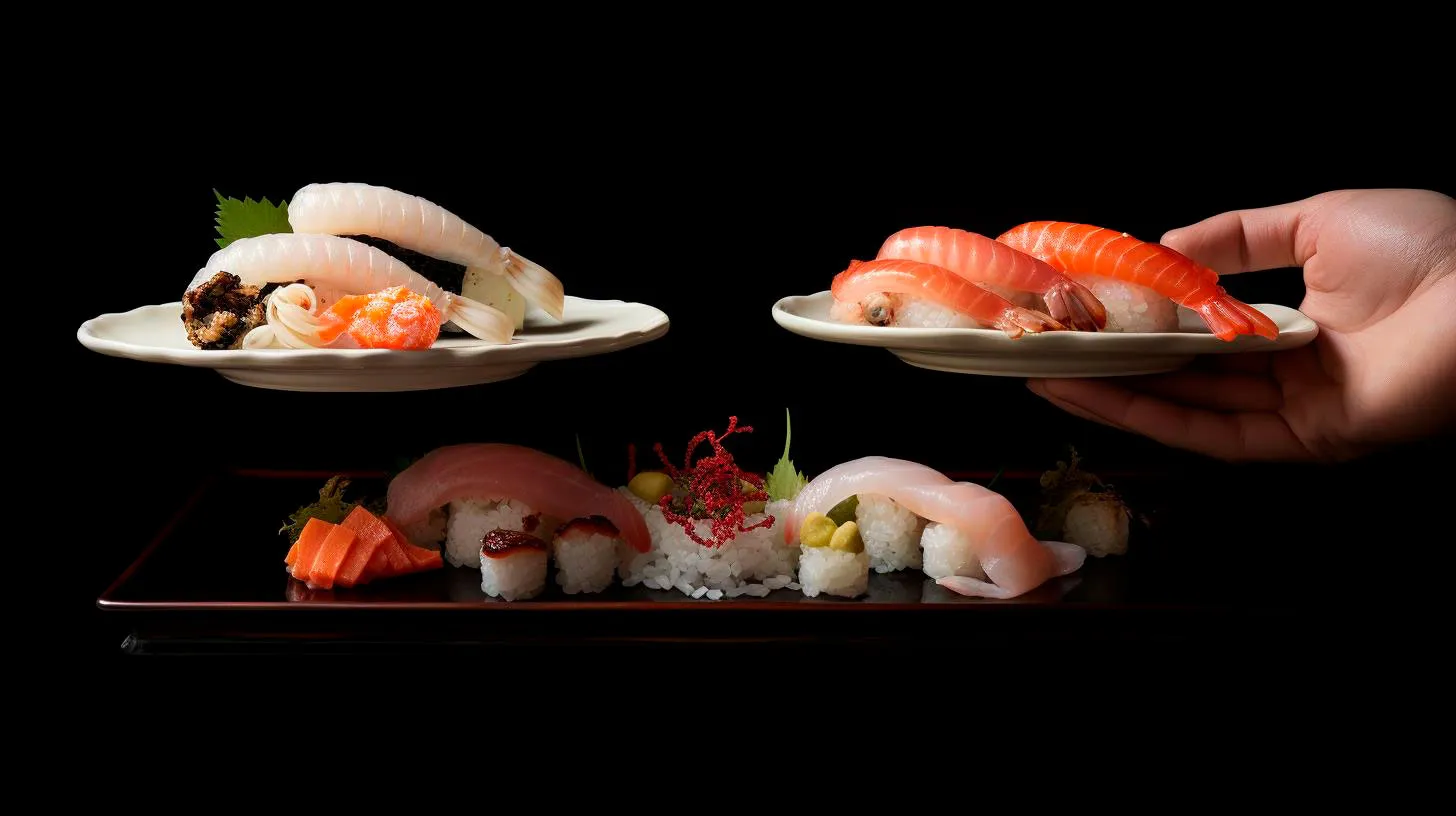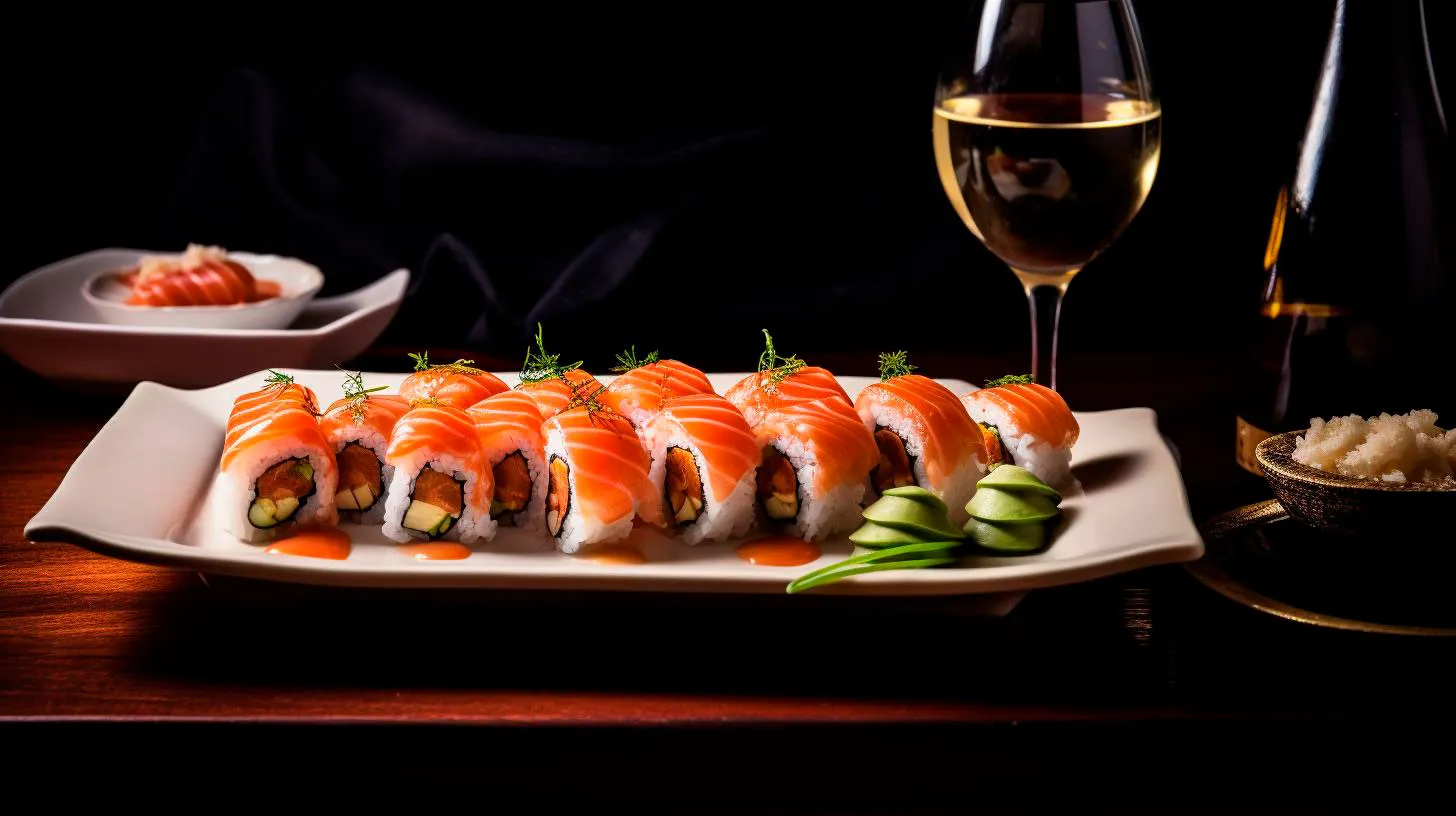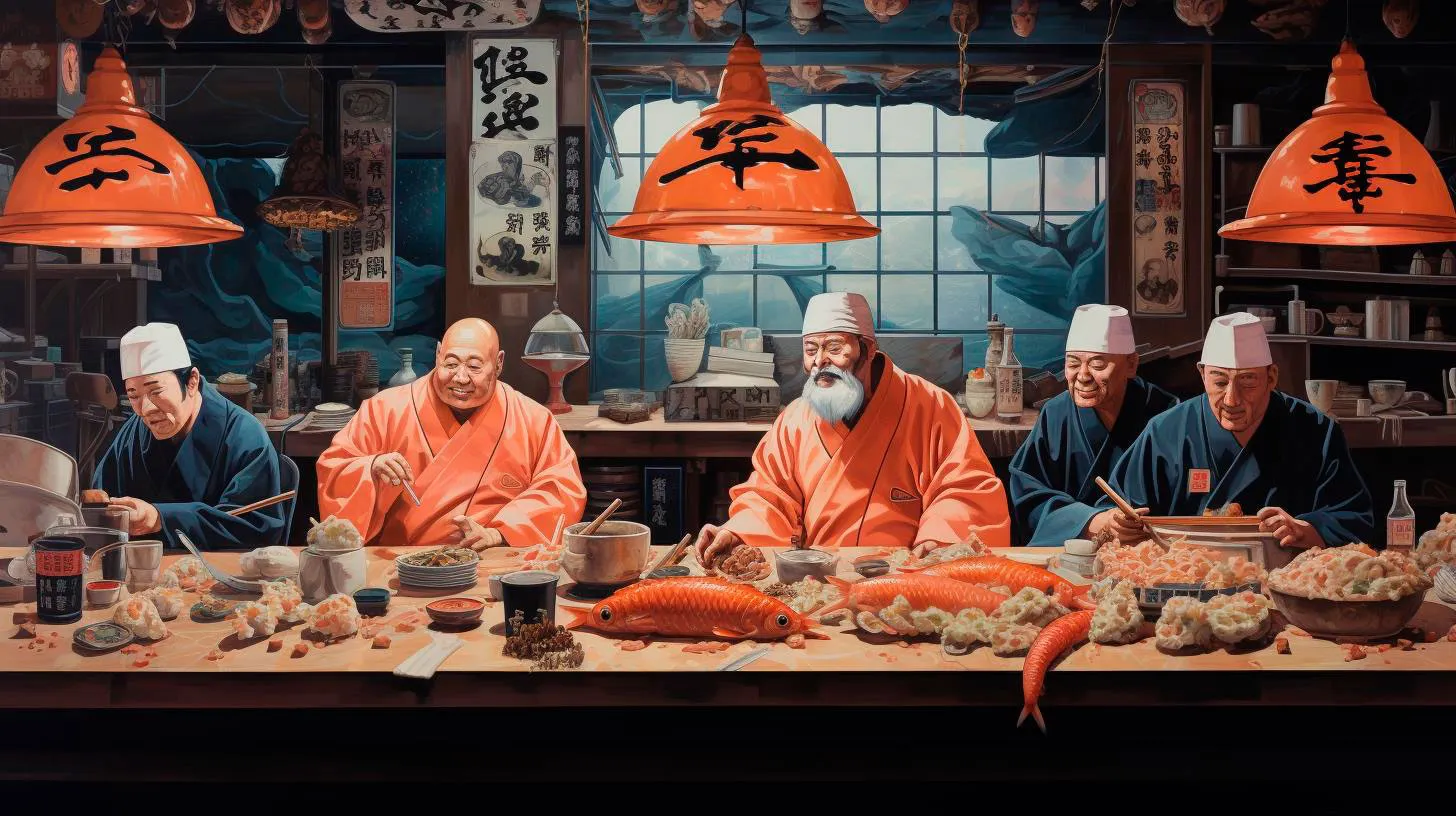The Art of Sushi Plating: Mastering the Basics
In this article, we’ll dive into the fascinating world of sushi plating and explore the key techniques, styles, and principles that sushi chefs follow to create visually stunning masterpieces.
The Importance of Sushi Plating
In Japanese culture, visual appeal is highly valued, and sushi is no exception. Sushi plating is not just about arranging the ingredients on a plate; it is an art form that combines aesthetics and culinary mastery. Here’s why sushi plating is paramount:
- Enhances the dining experience: Attractive sushi plating stimulates the senses and creates anticipation for the flavors that lie within. A beautifully presented dish heightens the overall enjoyment of the meal.
- Reflects the chef’s skill and creativity: The plating style reflects the chef’s technique, creativity, and attention to detail. It showcases their ability to transform simple ingredients into edible works of art.
- Creates a lasting impression: Instagram-worthy sushi plating catches the eye and leaves a lasting impression on diners. Social media has played a significant role in popularizing visually appealing sushi presentations.
The Basics of Sushi Plating
Mastering the art of sushi plating requires a deep understanding of the basic techniques and principles that govern this craft:
1. Balance and Harmony
In sushi plating, balance and harmony are crucial. It’s about achieving a visually pleasing composition by considering the placement of ingredients, colors, shapes, and textures on the plate. Each element should complement and balance the others. For example, a bright red slice of tuna can be paired with a green garnish to create an eye-catching color contrast.
2. Precision and Simplicity
Sushi plating revolves around simplicity and precision. Each element should be meticulously placed, and cluttering the plate with excessive garnishes should be avoided. The focus should be on the sushi itself, highlighting the quality of the ingredients.
3. Symmetry vs. Asymmetry
While sushi plating can be symmetrical, asymmetrical arrangements often yield more visually interesting results. Combining varying shapes and sizes of sushi, creating diagonal or diagonal-linear placements, and playing with negative spaces can create a visually dynamic presentation.
4. Utensils and Presentation Tools
Traditional sushi plating requires specific utensils and presentation tools to achieve the desired effect. Bamboo sushi mats, decorative chopsticks, small porcelain dishes for soy sauce, and specialized spoons for plating sauces are some commonly used tools that enhance the presentation.
Styles of Sushi Plating
Various styles of sushi plating have emerged over time, each with its own unique characteristics and approaches. Let’s explore a few popular ones:
1. Traditional Style
The traditional style focuses on simplicity and minimalism. Sushi is often arranged on a lacquer or ceramic plate, with garnishes kept to a minimum. This style lets the fresh flavors and textures of the sushi shine.
2. Modern Style
Modern sushi plating leans towards artistic and playful presentations. Chefs use innovative techniques to create intricate patterns, sculptures, or even edible landscapes on the plate. Colorful sauces, microgreens, and edible flowers are often incorporated to enhance the visual impact.
3. Omakase Style
The omakase style of sushi plating represents the chef’s culinary expression and creativity. Omakase, meaning “I’ll leave it up to you,” provides the chef with complete freedom to curate a customized sushi experience. Creative plating techniques, unique serving vessels, and surprising flavor combinations are hallmarks of this style.
Key Takeaways
Elevating your sushi plating skills requires practice, attention to detail, and a keen eye for aesthetics. Here are some key takeaways to remember:
- Balance and harmony are essential in sushi plating. Consider the colors, shapes, and textures of the ingredients to create visually appealing compositions.
- Precision and simplicity should guide your plating techniques. Avoid cluttering the plate and let the sushi speak for itself.
- Experiment with both symmetrical and asymmetrical arrangements to create visually dynamic presentations.
- Invest in the right utensils and presentation tools to elevate your sushi plating.
- Explore different styles of sushi plating, from traditional to modern and omakase, to broaden your creativity and inspire new presentations.
Mastering the art of sushi plating takes time and dedication, but the results are truly rewarding. By combining exceptional culinary skills with an artistic touch, sushi chefs can create an experience that delights both the eyes and the taste buds.
Elevate Your Sushi Game: Tips for Picture-Perfect Plating
Whether you’re a sushi aficionado or a curious beginner, mastering the art of picture-perfect plating can take your sushi game to new heights. In this article, we will explore some tips and tricks to help you create stunning sushi plates that are as visually enticing as they are delicious.
1. Colorful Components Create Contrast
When it comes to plating sushi, incorporating a variety of vibrant colors is key. The visual appeal of multi-colored ingredients enhances the overall presentation and makes every roll look appetizing. For example, combining red and orange ingredients such as tuna and salmon with vibrant green cucumber slices can create a striking contrast. The idea is to make every component of the dish visually appealing.
Additionally, garnishing your plate with colorful accessories like daikon radish or edible flowers can add another layer of visual interest. These accents not only enhance the aesthetics but also elevate the overall taste and texture of the dish.
2. Showcasing Texture and Shape
Texture plays a crucial role in sushi plating. By incorporating ingredients with different textures, such as crispy tempura, smooth avocado, or silky raw fish, you can create an enticing visual and tactile experience. Consider adding a variety of textures to your rolls to keep the palate engaged and create a visually appealing contrast on the plate.
Moreover, experimenting with different shapes is another way to enhance the presentation of your sushi. For instance, you can roll some sushi in a traditional cylindrical shape while creating others in a cone shape or even cutting them into square bites. By playing with shapes, you can create a visually stunning plate that looks like a work of art.
3. Attention to Details
Attention to detail is what separates a beautifully plated sushi dish from an ordinary one. Precise and careful cutting of fish and vegetables is crucial to ensure uniformity and symmetrical plating. Investing in quality, razor-sharp sushi knives will make a noticeable difference in the final presentation.
Small touches such as adding sesame seeds, microgreens, or a drizzle of flavorful sauce on top can elevate the visual appeal of your sushi rolls. Remember, it’s the little things that leave a lasting impression on your guests.
4. Utilize Negative Space
In sushi plating, negative space refers to the empty areas on the plate. Utilizing negative space creates a sense of balance and allows the sushi rolls to take center stage. Don’t overcrowd the plate with too many elements, as it can make the dish appear messy. Leaving enough negative space around the rolls will give them the attention they deserve.
Strategically positioning the rolls, garnishes, and dips throughout the plate can create an aesthetically pleasing arrangement. Experiment with different placement techniques to find what works best for your desired presentation.
Key Takeaways
- Incorporate a variety of colors to create a visually appealing contrast.
- Experiment with different textures and shapes to enhance the overall presentation.
- Pay attention to details such as precise cutting and small garnishes.
- Utilize negative space on the plate for a balanced and focused presentation.
Elevating your sushi game goes beyond mastering the art of rolling. By paying attention to plating techniques, you can create visually stunning plates that are sure to impress both your eyes and taste buds. Embrace your creativity, experiment with different colors, textures, and arrangements, and watch as your sushi transforms into a masterpiece.
From Plate to Canvas: Unleashing Creativity with Sushi Presentation
Sushi presentation is an art form that allows chefs to unleash their creativity and showcase their skills. In this article, we will dive deep into the world of sushi presentation and explore how it can elevate your dining experience.
The Artistry of Sushi Presentation
Sushi chefs go beyond taste when creating their masterpiece. They consider sushi as a form of art and take pride in their presentation skills. Here’s how sushi presentation unleashes creativity:
- Aesthetically Pleasing: Sushi is known for its vibrant colors, contrasting textures, and overall aesthetic appeal. Chefs use a variety of ingredients, such as fresh fish, colorful vegetables, and edible flowers, to create visually striking sushi rolls and nigiri.
- Knife Skills: Sushi presentation requires exceptional knife skills. Chefs master the art of slicing fish with precision, creating thin and uniform slices for a visually appealing final product.
- Arrangement: The placement of each sushi piece on the plate is carefully considered. Chefs take into account colors, shapes, and sizes to create a harmonious arrangement that pleases the eye.
Key Takeaways from Sushi Presentation
Discover the key takeaways that make sushi presentation a remarkable dining experience:
1. Visual Delight
Sushi presentation is a feast for the eyes. The attention to detail and creativity of the chef results in an artistic masterpiece that tantalizes the senses. The vibrant colors and intricate arrangements make sushi a visually delightful experience.
2. Appreciation for Freshness
One of the main principles of sushi presentation is using the freshest ingredients available. Chefs carefully select the best fish, vegetables, and other components to ensure the highest quality. Sushi presentation highlights the importance of freshness in enhancing flavors.
3. Cultural Connection
Sushi is deeply rooted in Japanese culture, and sushi presentation reflects this cultural connection. From traditional techniques to the use of seasonal ingredients, sushi presentation showcases the rich culinary heritage of Japan. It allows diners to appreciate and connect with Japanese traditions.
4. Unique Flavors and Combinations
Sushi presentation is not just about looks; it is an opportunity for chefs to experiment with flavors and combinations. By using various ingredients and techniques, sushi chefs create unique flavor profiles that surprise and delight diners.
Sushi Presentation in Numbers
Let’s explore some fascinating statistics that highlight the impact of sushi presentation:
- According to a survey, 36% of millennials choose a restaurant based on its Instagrammable food options. Sushi’s visually appealing presentation makes it a top choice for capturing that perfect food photo.
- A study found that people perceive food to taste better when it is visually appealing, leading to an increased satisfaction level. Sushi presentation plays a crucial role in enhancing the overall dining experience.
- Research shows that chefs who focus on presentation techniques receive higher ratings from customers, which leads to increased popularity and success of their restaurants.
In conclusion, sushi presentation goes beyond culinary skills. It is an art form that allows chefs to unleash their creativity and creates a memorable dining experience for customers. The aesthetic appeal, attention to detail, and cultural connection of sushi presentation make it a truly fascinating aspect of Japanese cuisine.
Creating Visual Masterpieces: Innovative Sushi Plating Techniques
In this article, we will explore some of the most remarkable sushi plating techniques that have captivated food enthusiasts worldwide.
1. Minimalist Elegance
The minimalist plating technique embraces simplicity, allowing the sushi’s natural colors and textures to shine. By arranging sushi pieces with clear lines and minimal garnishes, chefs create visually striking plates that emphasize the artistry of the ingredients. This approach not only highlights the beauty of the sushi but also showcases the skill and precision of the chef.
Key takeaways:
- Focus on clean lines and minimal garnishes.
- Allow the natural colors and textures of the sushi to be the star.
- Showcase the chef’s skill and precision through elegant arrangements.
2. Edible Landscapes
Edible landscapes take sushi plating to a whole new level by incorporating elements of nature into the presentation. Chefs create stunning scenes with sushi, transforming plates into miniature gardens or serene seascapes. By strategically placing sushi pieces and adding decorative elements like edible flowers or seaweed, they bring whimsy and artistry to the dining table.
Key takeaways:
- Use sushi pieces to create landscapes or seascapes.
- Add decorative elements like edible flowers or seaweed for an extra touch of artistry.
- Create a whimsical dining experience by turning plates into miniature gardens.
3. Playful Geometry
Playful geometry is all about creating visually striking patterns and shapes using sushi pieces. Chefs skillfully arrange sushi in a way that forms intricate designs, such as squares, circles, or even complex mosaics. By playing with different colors and textures, they transform each sushi platter into a work of art that delights both the eyes and the taste buds.
Key takeaways:
- Create visually striking patterns and shapes using sushi pieces.
- Experiment with different colors and textures to enhance the design.
- Transform each sushi platter into a sensory experience that delights both the eyes and the taste buds.
4. Unexpected Flair
To truly elevate the sushi experience, chefs often add unexpected elements to their plating. Whether it’s a surprising burst of flavor from a hidden ingredient or a clever use of non-traditional sushi components, the goal is to leave diners in awe. These unexpected twists not only make each dish memorable but also showcase the chef’s inventiveness and creativity.
Key takeaways:
- Add unexpected elements to surprise and delight diners.
- Incorporate hidden ingredients for a burst of unexpected flavor.
- Showcase the chef’s inventiveness and creativity through unconventional sushi components.
In conclusion, sushi plating techniques have evolved to create not only a gastronomic experience but also a visual feast. Whether through minimalist elegance, edible landscapes, playful geometry, or unexpected flair, sushi chefs around the world continue to push the boundaries of their craft. By embracing these innovative plating techniques, they infuse their creations with artistry, captivate the senses, and make each dining experience truly unforgettable.


